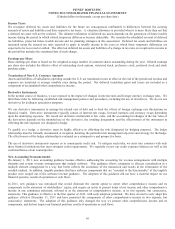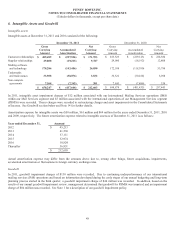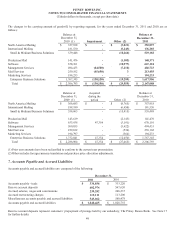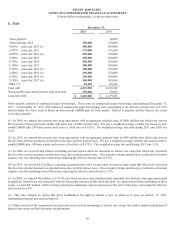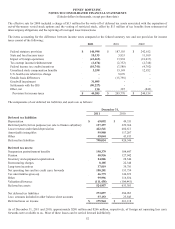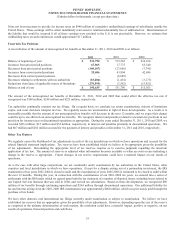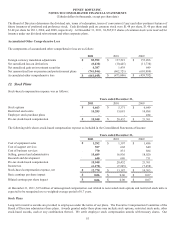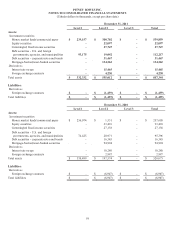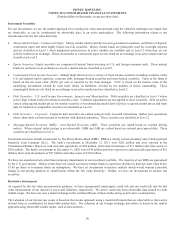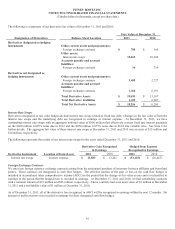Pitney Bowes 2011 Annual Report Download - page 71
Download and view the complete annual report
Please find page 71 of the 2011 Pitney Bowes annual report below. You can navigate through the pages in the report by either clicking on the pages listed below, or by using the keyword search tool below to find specific information within the annual report.
PITNEY BOWES INC.
NOTES TO CONSOLIDATED FINANCIAL STATEMENTS
(Tabular dollars in thousands, except per share data)
53
It has not been necessary to provide for income taxes on $940 million of cumulative undistributed earnings of subsidiaries outside the
United States. These earnings will be either indefinitely reinvested or remitted substantially free of additional tax. Determination of
the liability that would be incurred if all of these earnings were remitted to the U.S. is not practicable. However, we estimate that
withholding taxes on such remittances would approximate $17 million.
Uncertain Tax Positions
A reconciliation of the amount of unrecognized tax benefits at December 31, 2011, 2010 and 2009 is as follows:
2011 2010 2009
Balance at beginning of year $ 531,790 $ 515,565 $ 434,164
Increases from prior period positions 67,065 17,775 65,540
Decreases from prior period positions (140,107) (27,669) (7,741)
Increases from current period positions 28,686 43,804 42,696
Decreases from current period positions - (8,689) -
Decreases relating to settlements with tax authorities (18,204) (1,434) (3,173)
Reductions from lapse of applicable statute of limitations (270,595) (7,562) (15,921)
Balance at end of year $ 198,635 $ 531,790 $ 515,565
The amount of the unrecognized tax benefits at December 31, 2011, 2010 and 2009 that would affect the effective tax rate if
recognized was $160 million, $249 million and $225 million, respectively.
Tax authorities continually examine our tax filings. On a regular basis, we conclude tax return examinations, statutes of limitations
expire, and court decisions interpret tax law. We regularly assess tax uncertainties in light of these developments. As a result, it is
reasonably possible that the amount of our unrecognized tax benefits will decrease in the next 12 months, and we expect this change
could be up to one-third of our unrecognized tax benefits. We recognize interest and penalties related to uncertain tax positions in our
provision for income taxes or discontinued operations as appropriate. During the years ended December 31, 2011, 2010 and 2009, we
recorded $(83) million, $15 million and $32 million, respectively, in interest and penalties primarily in discontinued operations. We
had $67 million and $202 million accrued for the payment of interest and penalties at December 31, 2011 and 2010, respectively.
Other Tax Matters
We regularly assess the likelihood of tax adjustments in each of the tax jurisdictions in which we have operations and account for the
related financial statement implications. Tax reserves have been established which we believe to be appropriate given the possibility
of tax adjustments. Determining the appropriate level of tax reserves requires us to exercise judgment regarding the uncertain
application of tax law. The amount of reserves is adjusted when information becomes available or when an event occurs indicating a
change in the reserve is appropriate. Future changes in tax reserve requirements could have a material impact on our results of
operations.
As is the case with other large corporations, we are continually under examination by tax authorities in the United States, other
countries and local jurisdictions in which we have operations. Except for a dispute arising out of a partnership investment, the IRS
examination of tax years 2001-2004 is closed to audit and the examination of years 2005-2008 is estimated to be closed to audit within
the next 12 months. During the year, in connection with the examinations of our 2001-2008 tax years, we entered into a series of
settlements with the IRS under which we agreed upon both the tax treatment of a number of disputed issues, including issues related to
our Capital Services business that was sold in 2006, and revised tax calculations. Based on these developments, we recognized $90
million of tax benefits through continuing operations and $264 million through discontinued operations. Our additional liability for
tax and interest arising from the 2001-2008 IRS examinations was approximately $400 million, which was previously paid through the
purchase of tax bonds.
We have other domestic and international tax filings currently under examination or subject to examination. We believe we have
established tax reserves that are appropriate given the possibility of tax adjustments. However, depending upon the size of the reserve
as compared to the ultimate determination of such matters, the resolution could have a material impact, positive or negative, on our
results of operations, financial position and cash flows.




